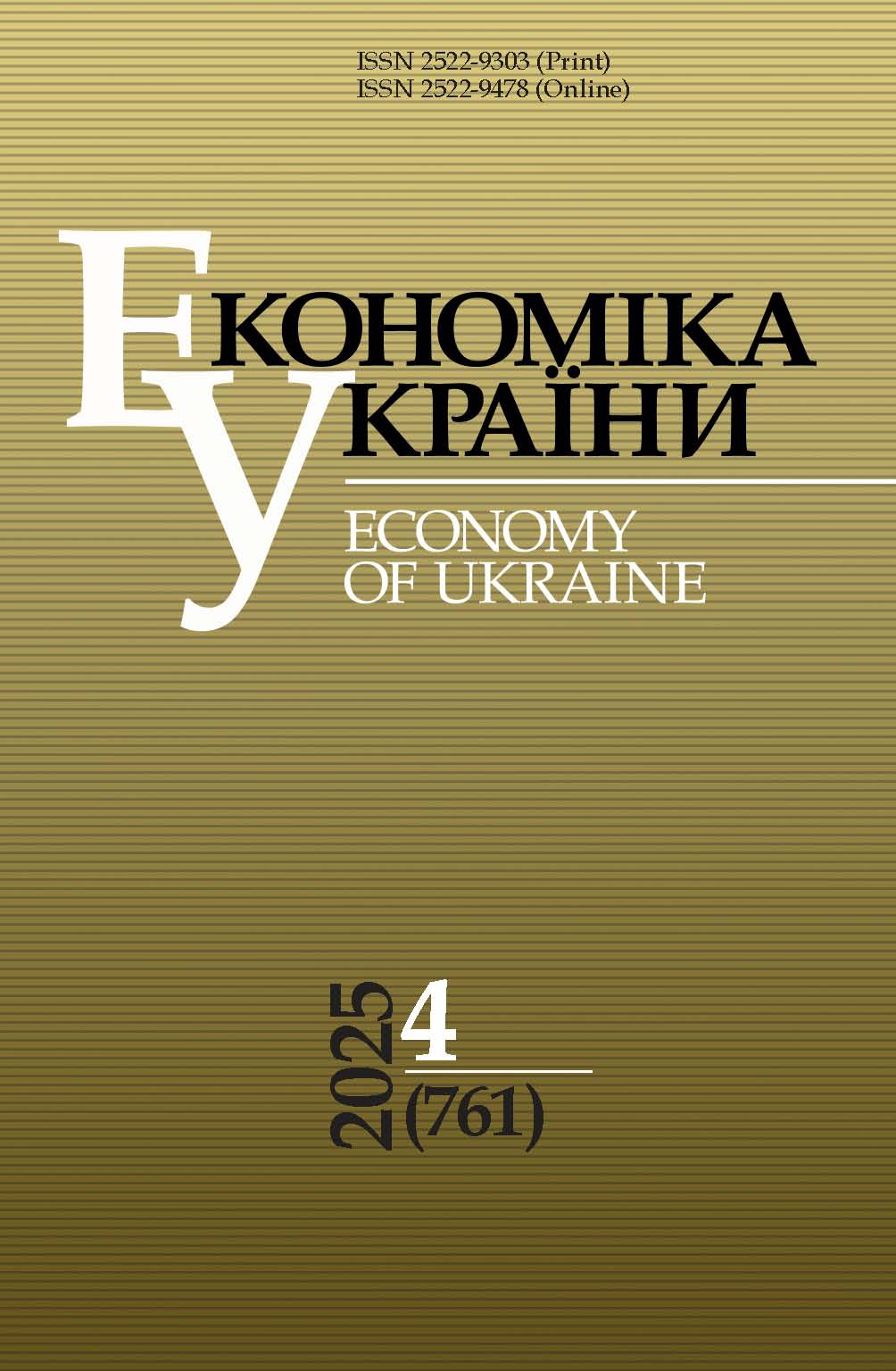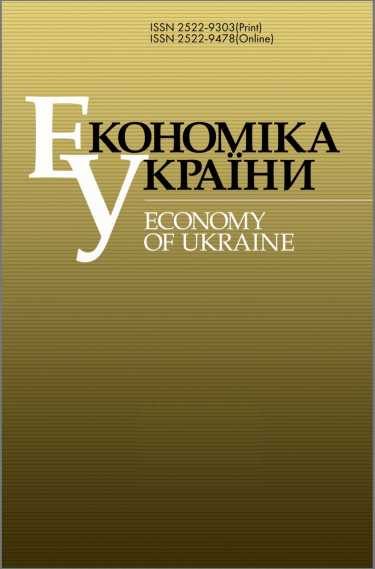SOCIAL VULNERABILITY IN THE CONTEXT OF THE HISTORICAL HERITAGE OF PATERNALISM
DOI:
https://doi.org/10.15407/economyukr.2025.04.090Keywords:
path dependence; state paternalism; social vulnerability; wartime economy; post-war reconstruction; economic historyAbstract
The ongoing war and its consequences are increasing the public demand for various forms of assistance and social support from the state. In this context, the impact of the historical heritage of paternalism on the social vulnerability of the population of Ukraine is revealed, and directions for supporting modern positive trends in diversifying social vulnerability reduction mechanisms are outlined.
The persistent stereotypes of public consciousness and individual behavior that were formed in Soviet times were based on the features of the centrally planned economic system, where state paternalism was the dominant model of social security. Based on the study of path dependence, risks for society, the state, and the economy were identified, as well as factors of social vulnerability of the population (fundamental and current), which are based on the traditions of state paternalism. The inconsistency of the historically formed tradition of passive expectation and reliance on the state with modern realities and challenges is proven.
The study summarizes the foreign experience of proactive social policy during post-war economic reconstruction. The key features of that experience were: redistribution of social functions between the state and business, positive experience of partnership between the state and corporations, development of the economy of social partnership relations, institutionalization of social functions of the state, various forms of economic self-organization of the population for post-war recovery, support for producers, not consumers.
Directions for supporting modern positive trends in diversifying mechanisms for reducing the social vulnerability of the population are proposed, in particular: development of social responsibility of business, spread of sharing economy as a form of joint use of limited resources, community participation in social service provision, formation of commercial social services, social volunteering and charity. The need to abandon the established redistributive practices of social dependency to reduce social vulnerability is emphasized, mechanisms for redistributing social functions between the state and business are proposed, and the main functions of the state for restructuring the social protection system are identified.
References
Yelisieieva, L. (2019). Antisocial capital and its network effects. Economy and Society. 20. 3-10. https://doi.org/10.32782/2524-0072/2019-20-1 [in Ukrainian].
Munko, A. (2023). Modern financial tools for community development: away from budget paternalism. Scientific Bulletin of Vinnytsia Academy of Continuing Education. Series "Ecology. Public Administration". 3. 129-134. https://doi.org/10.32782/2786-5681-2023-3.17 [in Ukrainian].
Burton, C., Rufat, S., Tate, E. (2018). Social Vulnerability: Conceptual Foundations and Geospatial Modeling. In: Vulnerability and Resilience to Natural Hazards. S. Fuchs, T. Thaler (Eds.). Cambridge University Press. P. 53-81. https://doi.org/10.1017/9781316651148
Buckle, P., Mars, G., Smale, R. (2000). New approaches to assessing vulnerability and resilience. Australian Journal of Emergency Management. 15(2). 8-14. URL: https://classic.austlii.edu.au/au/journals/AUJlEmMgmt/2000/19.html
Beccari, B. (2016). A comparative analysis of disaster risk, vulnerability and resilience composite indicators. PLOS Currents Disasters. https://doi.org/10.1371/currents.dis.453df025e34b682e9737f95070f9b970
Makarova, O. (2017). Priorities for social vulnerability reduction policy. Demography and social economy. 2(30). 102-111. https://doi.org/10.15407/dse2017.02.102 [in Ukrainian].
Ryndzak, O. (2021). Social vulnerability of the population and its conceptual and terminological provision. Economy and Society. 33. https://doi.org/10.32782/2524-0072/2021-33-79 [in Ukrainian].
Bil, M. (2021). Concept of the population social vulnerability: retrospective of formation and modern interpretations. Social Economics. 62. 20-30. https://doi.org/10.26565/2524-2547-2021-62-02 [in Ukrainian].
Andrusyshyn, N. (2022). Social vulnerability of the population: definitions, approaches to understanding and evaluation. Economy and Society. 37. https://doi.org/10.32782/2524-0072/2022-37-42 [in Ukrainian].
Bidak, V. (2023). Social vulnerability of the population of Ukraine in the focus of strengthening national security. Regional Economy. 109(3). 70-85. https://doi.org/10.36818/1562-0905-2023-3-6 [in Ukrainian].
Vasyltsiv, Т., Mulska, О., Lupak, R., Bidak, V. (2022). Preservation of Ukraine's human capital in conditions of war (factor of social vulnerability of the population): statement of the problem. Herald of LUTE. Economic Sciences. 67. 43-48. https://doi.org/10.36477/2522-1205-2022-67-06 [in Ukrainian].
Semiv, L., Mulska, O. (2022). Social vulnerability of the population of Ukraine: conceptual and spatial modeling. Regional Economy. 1(103). 31-42. https://doi.org/10.36818/1562-0905-2022-1-3 [in Ukrainian].
Hnatchuk, O., Shestakova, K. (2024). Current challenges of social protection of the population in Ukraine: analysis of key trends. Economies’ Horizons. 1(27). 4-17. https://doi.org/10.31499/2616-5236.1(27).2024.297534 [in Ukrainian].
Merisalu, E., Demikhov, O., Letunovska, N., Taraniuk, L. (2024). Public Administration System of Social Security Transformation in Ukraine Within the War: Housing, Food, and Medical Care Aspects. Economic Sustainability and Business Practices. 1(1). 1-8. https://doi.org/10.21272/esbp.2024.3-01
Cherenko, L. (2023). Targeting of social programs at vulnerable groups: sustainable trends and post-war prospects. Demography and Social Economy. 1(51). 73-95. https://doi.org/10.15407/dse2023.01.073 [in Ukrainian].
Tverdovskiy, A. (2016). The Soviet policy of social security in the context of the formation of the totalitarian state and society in the 1920s (based on the materials of state archives of Kherson region). Part. 3. Scholarly Works of the Faculty of History, Zaporizhzhia National University. 46. 209-216. URL: https://istznu.org/index.php/journal/article/view/487/459 [in Ukrainian].
Kahneman, D., Tversky, A. (1979). Prospect Theory: An Analysis of Decision under Risk. Econometrica. 47(2). 263-291. https://doi.org/10.2307/1914185
Akulenko, L., Balakireva, O., Volosevych, I., Dmytruk, D., Kostiuchenko, T., Latsyba, I., Pavlova, D. et al. (2020). Ukraine in World Values Survey 2020. Kyiv, Ukrainian Centre for European Policy. 215 p. URL: https://ucep.org.ua/doslidzhennya/world-values-survey-2020-in-ukraine.html [in Ukrainian].
Balakireva, O., Dmytruk, D. (2020). Socio-economic attitudes of the Ukrainian population at the end of 2020. Ukrainian Society. 4(75). 136-155. https://doi.org/10.15407/socium2020.04.136 [in Ukrainian].
Hayek, F. (1992). The Fatal Conceit: The Errors of Socialism. W. Bartley (Ed.). Routledge. URL: https://www.mises.at/static/literatur/Buch/hayek-the-fatal-conceit.pdf
Heyets, V., Grytsenko, A., Iefymenko, T. et al. (2022). Restoration and reconstruction of Ukraine’s post-war economy. Kyiv. 305 p. URL: https://ief.org.ua/publication/naukovi-dopovidi/2022/vidnovlennja-ta-rekonstrukcija-povoennoi-ekonomiky-ukrainy [in Ukrainian].
Balakireva, O., Bielinska, V., Bilous, Ye., Dmytruk, D., Koval, N., Levin, R., Yatsenko, H. (2022). Value component of economic orientations and behavior. R. Levin (Ed.). Kyiv. 152 p. URL: https://ief.org.ua/publication/naukovi-dopovidi/2022/cinnisna-skladova-ekonomichnykh-orientaciy-ta-povedinky [in Ukrainian].
Kurylo, I. (2023). Elderly in Ukraine during the war: situation, needs, examples of resilience. Ukrainian Society. 4(87). 9-20. https://doi.org/10.15407/socium2023.04.009
Vasyltsiv, T., Mulska, O. (2023). The potential of internally displaced persons is a trigger for economic recovery in regions. In: The economics of urban renewal. Proc. International Urbanistic Forum (Kyiv, March 22–23, 2023). 410 p. P. 30-33. URL: https://drive.google.com/file/d/1lH2N6GcXZHPFBC7o2P_QS85cqjQ8nRn_/view [in Ukrainian].
Slyvka, T. (2022). German concerns: post-war revival and the role in economic recovery. History of economics and economic thought of Ukraine. 55. 63-76. https://doi.org/10.15407/ingedu2022.55.063 [in Ukrainian].
Horditsa, K. (2024). Regulation of employment and social and labor relations in the post-war period: the experience of Western Europe. Scientific Collection “InterConf+”. 47(209). 17-29. https://doi.org/10.51582/interconf.19-20.07.2024.002 [in Ukrainian].
Didkivska, L. (2023a). The evolution of the Anglo-Saxon economic model: the social dimension. Grail of Science. 25. 29-33. https://doi.org/10.36074/grail-of-science.17.03.2023.001 [in Ukrainian].
Didkivska, L. (2023b). Foreign experience of post-war rural territory and agricultural recovery for Ukraine's reconstruction. History of economics and economic thought of Ukraine. 56. 44-61. https://doi.org/10.15407/ingedu2023.56.044 [in Ukrainian].
Honcharenko, V., Panteleimonenko, A. (2024). Theoretical aspects of «the third sector» and subjects of «social economy» development in Ukraine. Economic Scope. 190. 167-173. https://doi.org/10.32782/2224-6282/190-31 [in Ukrainian].
Erhard, L. (1958). Prosperity through competition. New York, Frederick A. Praeger. https://doi.org/10.2307/2551508
Nebrat, V. (2024). Transformation of Ukrainian entrepreneurship and the potential of socio-economic solidarism in a wartime economy. In: Economic prospects of entrepreneurship: challenges of wartime and post-war reconstruction. Proc. VII Int. Sci.-Pract. Conf. (Irpin, May 31, 2024). Irpin. 628 p. P. 81-86. URL: https://dpu.edu.ua/images/2024/Photo_dlya_novyn_2024/Kafedra%20ekonomiki%20pidpriemnictva%20ta%20biznes-administruvanna/ZBIRNIK_Konferencia_Ekonomicni_perspektivi_pidpriemnictva_31.05.2024__.pdf [in Ukrainian].
Nebrat, V., Kurbet, O., Bodnarchuk, T. (2022). Educational mobility in time of war: risks of human potential’s losses in Ukraine. In: The Russian-Ukrainian war (2014–2022): historical, political, cultural-educational, religious, economic, and legal aspects. Riga, Baltija Publishing. P. 218-223. https://doi.org/10.30525/978-9934-26-223-4-29 [in Ukrainian].
Downloads
Published
How to Cite
Issue
Section
License
Copyright (c) 2025 Publisher PH "Academperiodyka" of the NAS of Ukraine

This work is licensed under a Creative Commons Attribution-NonCommercial-NoDerivatives 4.0 International License.



